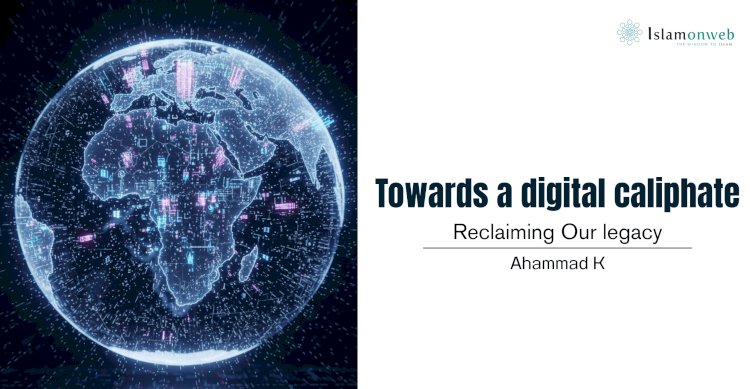Towards a digital caliphate: Reclaiming Our legacy
I was sitting with my friends when a round of 7 Up was served. Some of us, myself included, politely declined. Most of my friends, however, drank it without a second thought, asking, "Who cares about these boycotts? If we paid attention to every single one, what could we ever drink or use?" I was stunned by his words. I felt ashamed, wondering how he could ignore these movements after all he had seen in the news and elsewhere. Yet, despite his dismissiveness, the campaign was undeniably successful in its own way.
The boycott campaign was a wildfire, spreading through WhatsApp groups and social media feeds, driven not by any central command but by a collective digital conscience. When news broke that the company was losing billions, it was a profound moment of realization for millions of us.
This wasn't just about a single boycott. It was a revelation. We, as a scattered global community, had stumbled upon a hidden power source: our unified economic and social influence. We've always been told we are a population of two billion, a mighty force in sheer numbers. But for so long, that power has felt dormant, an untapped ocean of potential. The online campaigns revealed that the internet and digital world could be the key to unlocking it, transforming our individual beliefs into a powerful, coordinated force for change. This is the genesis of an idea that is both old and new: the Digital Caliphate.
It was a coincidence that I later watched a conversation on the "Thinking Muslim" podcast with Abdurahman Chris Blauvelt, CEO of Launch Good. He expressed some concerns and more hope about the idea of a digital caliphate. This article introduces the idea of the Digital Caliphate, combining Abdurahman Chris Blauvelt's insightful ideas with my own thoughts on this evolving concept.
The traditional idea of a Caliphate, a unified leadership under a single banner, dissolved a century ago, leaving us as a body without a head by 1920, at the end of the Ottoman Caliphate. Our leaders, often tied to narrow national interests, frequently bend to the will of global giants, leaving our brothers and sisters to face oppression alone. From the persecuted Uyghurs in China, whose heritage is being systematically erased, to the desperate Rohingya fleeing violence by land and sea, the calls for help have often been met with deafening silence from those in power. We cannot wait any longer for them. We have to be the leaders we wish to see.
This brings us to the very idea of a Digital Caliphate. It's not a political state or a physical territory. Instead, imagine it as a virtual home for the global Ummah—a parallel ecosystem built on our shared values, powered by technology, and united by a common purpose. This is our chance to build a sanctuary where we can reclaim our identity and our agency.
The Call for a Cohesive Community
For too long, the Muslim world has been defined by its problems. Reports from places like Afghanistan, Somalia, Pakistan, and Palestine dominate the news, painting a picture of displacement, poverty, and war. A staggering 250 million Muslim children are out of school, their futures at risk, yet the solutions offered are often piecemeal and fragmented. We raise money through various charities, but there is no central mechanism to ensure these resources are maximized for the greatest impact. There is no strategic, unified plan.
The plight of Muslims outside the Majority-Muslim world is just as dire. Recent reports from India, for example, have described the brutal treatment of Rohingya refugees, including accounts of them being cast into the sea. These are not isolated incidents; they are symptoms of a global apathy toward our collective suffering. It's easy for the world to look away when our own leaders do.
This is where the Digital Caliphate can change the game. It's an idea that recognizes the power of solidarity and puts it to work. We are not just victims; we are also a force for positive change. We are innovators, entrepreneurs, and humanitarians. The Digital Caliphate is simply a framework to connect these disparate energies into a single, unstoppable current.
From Boycotts to Builders
The success of the Gaza-related boycotts was a powerful start, but it was just the beginning. The real challenge is to transition from simply reacting to building. We need to create a space where we can not only exert pressure on the outside world but also build a self-sufficient world of our own.
Consider platforms like LaunchGood. It's a brilliant example of a micro-Caliphate in action. It allows us to come together and collectively fund causes, from feeding the displaced in Afghanistan to supporting educational projects for the 250 million Muslim children currently out of school. It shows us that when we pool our resources, we can solve problems that seemed insurmountable. A true Digital Caliphate would expand on this, creating its own digital currency and a robust economic backbone capable of funding research, startups, and humanitarian efforts without relying on external, often biased systems. The potential is immense. Imagine if a small, voluntary tax were levied on our digital citizens, with the billions of dollars collected being funneled directly into building schools, hospitals, and technological infrastructure for the Ummah.
This becomes especially critical when we look at the world of technology. The algorithms that shape our lives are not neutral. The biases within them are subtle but pervasive, from payment gateways that block transactions for Muslim organizations to search engines that whitewash the suffering of the Uyghurs. The next frontier isn't just about using technology; it's about creating it.
We need to nurture a new generation of Muslim tech leaders. We need to build our own Large Language Models (LLMs) infused with our values and knowledge, to create an AI that understands us rather than one that perpetuates stereotypes. This isn't just for us; it's for everyone. When we build ethical, unbiased technology, the entire world benefits.
The Infrastructure of a Digital Ummah
Building a Digital Caliphate isn't just a philosophical exercise; it requires a practical plan. The "digital railway" of our time would consist of several key pillars: A Shared Digital Economy is the primary. It would include an Islamic-based digital currency that operates outside the conventional financial systems, as well as a network of Muslim-owned e-commerce platforms and payment gateways. This would not only facilitate trade but also ensure that our economic activity directly benefits our own communities.
Technological Innovation Hubs is the second because we need to fund and support research labs and tech incubators dedicated to creating software and hardware aligned with Islamic values, like developing our own social media platforms, search engines, and AI models that are free from the biases we so often encounter.
Inspired by models like Launch Good, Collective Action Fund is the third one. This fund would be a global endowment, a source of capital for everything from disaster relief to educational scholarships and tech startups. It would be transparent and democratically managed by a diverse council from across the globe.
Digital Territory is the last one. It would be a secure online space for communication, collaboration, and education. Imagine an encrypted platform where Muslims can connect, share ideas, and organize campaigns without fear of surveillance or censorship. This would be our virtual town square, a place to discuss, debate, and strategize for the future of the Ummah.
Just as the Hijaz Railway once connected Muslim lands in a physical network, we now have the opportunity to build a digital one.
This network will not be a source of political authority, but a fountain of shared prosperity and mutual support. It will be a place where a Muslim in Malabar can directly support a project in Xinjiang, where a startup in London can get funding from investors in the Middle East, and where a family in India can find a voice in a global collective.
The vision of a Digital Caliphate is about more than just technology or money. It is about a spiritual and social awakening. It is about reclaiming our narrative and our destiny. It's about building a virtual home where every Muslim, wherever they are, can feel a sense of belonging and hope. We no longer have to wait for a leader to rise; we are the leaders, and our collective power is just a click away.
About the author:
Ahammad K. is a postgraduate student at Darul Huda Islamic University. He is currently pursuing his bachelor's degree in Politics at Calicut University. His research interests are Muslim identity and Ummatics and global politics
References:
- The Thinking Muslim Podcast. "Are We Ready for a Digital Caliphate? With Chris Abdur-Rahman Blauvelt." Accessed August 20, 2025. https://www.thinkingmuslim.com/podcast/chris-blauvelt-digital-caliphate-p5wfg-5pz2e.
- Kosumi, Blerta. "LaunchGood Explains Their Giving Ecosystem." IslamiCity, June 27, 2024. Accessed August 21, 2025. https://www.islamicity.org/102075/launchgood-explains-their-giving-ecosystem/.
- Yaqeen Institute for Islamic Research. "LaunchGood Supporting to Raise the Standard of the Ummah's Education." Yaqeen Institute, February 14, 2024. Accessed August 22, 2025. https://yaqeeninstitute.org/read/post/impact-of-islamic-educational-apps-for-on-the-go-learning-2.
- ET Online. "ET Make in India SME Regional Summits: How Lahori Zeera Stormed India's Beverage Aisles." The Economic Times, August 13, 2025. Accessed August 23, 2025. https://economictimes.indiatimes.com/small-biz/sme-sector/et-make-in-india-sme-regional-summits-how-lahori-zeera-stormed-indias-beverage-aisles/articleshow/123285239.cms.
- The Economic Times. "Starbucks Loses USD 11 Billion Due to Poor Sales, Boycotts." December 7, 2023. Accessed August 21, 2025. https://economictimes.indiatimes.com/news/international/business/starbucks-loses-usd11-billion-due-to-poor-sales-boycotts/articleshow/105806376.cms.
- Abdulla, Shaheen. "Indian Authorities Allegedly Threw 40 Rohingya Refugees, Including Children, into International Waters Near Myanmar." Maktoob Media, May 12, 2025. Modified May 17, 2025. Accessed August 22, 2025. https://maktoobmedia.com/features/indian-authorities-allegedly-threw-43-rohingya-refugees-including-children-into-international-waters-near-myanmar/.
Disclaimer
The views expressed in this article are the author’s own and do not necessarily mirror Islamonweb’s editorial stance.























Leave A Comment